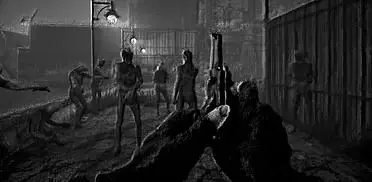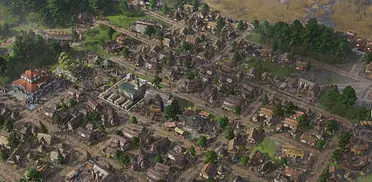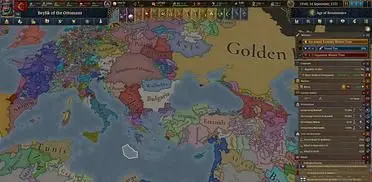Moonlight bathes Egypt’s open desert as I prepare to siege a nearby settlement that produces much-needed food. Ramesses becoming Pharaoh remains a distant dream if my economy cannot properly support a growing army and, having secured bronze for gear and stone for construction, I need to make sure that my troops stay fed. Then, my unfortunate Canaanite neighbors will help cement Ramesses’ legacy as a potent conqueror.
The initial 50 turns of Ramesses’ Total War: Pharaoh campaign evoke a sense of familiarity, even for those who haven’t extensively delved into Creative Assembly Sofia’s previous Bronze Age game, Troy. The essence of the broader series is unmistakably present in its renewed focus on pure historical gameplay.
I start with a handful of settlements that make up a province alongside an army led by Ramesses himself. If I plan on succeeding, I need to grow my kingdom through warfare, trade, and diplomacy. A weak, conveniently placed enemy army fuels my engine of conquest, and it’s not long until I start considering the best approach to painting the map in my faction’s color.
But the latest entry in the series also includes several tweaks to the formula, attempting to make the road to becoming Pharaoh interesting and bring the historical context surrounding your efforts to life.
Aside from the traditional structures, every region has a specific number of points of interest where various types of Outposts can be established. You can construct shrines to enhance favor with the gods you worship, forts and lookout posts to station armies that assist during sieges, monuments to increase Legitimacy, and waystations or trading posts.
Total War: Pharaoh introduces a modified approach to defining victory by splitting it into three levels, each requiring different Victory Point thresholds. Players earn these points by completing objectives like conquering lands of their own culture, penetrating enemy territories, ascending as the Pharaoh, or surviving an invasion by the Sea Peoples. Although many objectives remained undiscovered during my playthrough, they serve as valuable guidance for players who might feel directionless during a campaign.
Early in the game, players face a significant decision: to aim for the role of either Pharaoh or the Hittite Great King. Once chosen, this decision is locked for the rest of the playthrough. Having opted for the Pharaoh role, I announced my intentions as a contender and began exploring methods to accrue Legitimacy, the primary resource needed to stake a claim to the throne.
This decision granted me access to the Court, a mechanism designed to enhance your Legitimacy and unlock a range of other boons. The Egyptian and Hittite Courts feature different roles, and players can only access the one specific to their selected path.
You have the option to occupy vacant positions within the Court, granting you their associated passive bonuses. Even if you don’t hold a position, interactions with other court members are still possible. Engage in Intrigues to employ Court Actions and earn Renown with each member. This currency can subsequently be used for Requests, providing access to elite or unique units, acquiring a specified amount of gold, or lowering construction expenses.
Plots then allow you to either forcefully claim a Court position for yourself, gain more Renown, or steal your target’s Legitimacy at the risk of losing some of your own if your plans are discovered.
The Court interface itself isn’t particularly lively, but I ended up returning to this simple menu housing 2D portraits each turn. An infusion of gold or instant access to Kushite units to diversify an army’s roster when their lands are not within reach could always prove useful.
Shemsu Hor is an event that occurs during every 6th turn, marking the passage of an in-game year. It not only resolves active Court Plots, determining whether they succeed or fail but also alters Faction Commands. The latter are unique abilities with longer cooldowns that are available to each playable ruler.
By default, Ramesses’ Faction Command allows his armies to attack while in March stance, with units entering battle in Fresh condition until the end of the turn. If activated during Shemsu Hor, the effect instead adds elite Medjay Warriors to his special recruitment pool, allowing him to instantly add them to his armies, provided he has the necessary resources.
Total War: Pharaoh also features multiple gods belonging to the pantheons of its three cultures. You can worship up to three discovered gods of the 19 available, building monuments and temples to gain favor and reap increasingly powerful rewards. Upon reaching the second favor tier, you can also devote a general to a worshipped god, granting his army more passive bonuses.
Royal Decrees then act as a rather underwhelming tech tree, at least during the early stages of the campaign. Linked technologies provide passive bonuses to resource gains, recruitment, construction time, or cost reduction, often only covering a certain category of buildings or units. Helpful they may be, but I can’t say I was ever excited to click on any of them, even if having more food during times of crisis might as well have made the difference between victory and failure.
Ancient Legacies are another means of nudging your Total War: Pharaoh playthrough in a chosen direction. Much like picking between pursuing the title of Pharaoh or Hittite Great King, these are also locked in once selected.
 Ancient Legacies guide the direction of playthroughs, focusing on aspects like conquest or religion.
Ancient Legacies guide the direction of playthroughs, focusing on aspects like conquest or religion.
Walking in the footsteps of Thutmose the Conqueror gave me the option of targeting specific cities on the campaign map. I could then use special actions to either gain passive bonuses via the Sabotage path or receive reinforcing units by leaning into its Native Support counterpart. Other Legacies allow you to focus on building monumental pyramids or go for a playthrough leaning more into religion.
I ventured into Canaanite territory with the primary objective of conquering Ashkelon. I proceeded with this despite my army continually depleting my food reserves. Notably, AI factions frequently extended fairly reasonable bartering offers involving food, which bolstered my conquest endeavors.
As I neared the 50-turn limit of my preview session, I failed to conquer Ashkelon because of the return of the Sea Peoples. Intended as Total War: Pharaoh’s endgame crisis, they actually make their presence known early on, sending modest fleets to raid Egypt.
I had beaten their starting armies fairly easily, but my unguarded settlements fared much worse when they returned in higher numbers. They razed two of my food-producing settlements, sending my already struggling economy into swift decline.
This soon led to rebellions, and I wrapped things up with a burning kingdom and a handful of lessons learned.
As familiar as it will feel to players of prior Total War games, Pharaoh’s flow is different, requiring a more methodical approach than, say, the more streamlined Warhammer titles.
The slower pace of real-time battles also makes itself felt immediately, with units being a bit harder to move around. Tactical use of the terrain – like charging downhill, which deals more damage – and proper use of bottlenecks can, if not turn the tide of battle in your favor, deal significant damage to a numerically superior foe.
I learned that the hard way when stubbornly attempting to fight an inferior force on top of a settlement’s walls. Facing the enemy head-on, I received more casualties than I would have by simply auto-resolving. The return of siege equipment that needs to be built beforehand is, however, one of the most inspired decisions the developer has taken.
Coming to grips with it all meant that, while I did gather Legitimacy to rank just below the sitting Pharaoh, I couldn’t stretch my forces enough to viably participate in the civil war that could have granted me the sought-after position. This also means that I didn’t interact with the additional mechanics gained by taking the crown.
Each resource can potentially become a limiting factor, necessitating a more strategic economic approach. Without food and bronze, you can’t maintain your army; lacking stone or wood might prevent upgrading your fishery. This, in turn, could hinder you from feeding and enlisting additional troops in the future. Fixing resource shortages, the race for Legitimacy, and the need to expand in order to discover new gods and native units are only a few of the moving parts that encourage you to explore and conquer more of Egypt and the lands beyond it.
The quest to become Pharaoh, along with challenges like the Ancient Legacies, the Sea Peoples, and the decaying state of the world, ensures an engaging campaign. This experience can be tailored through numerous options available at the campaign’s onset. While the effort to bring Bronze Age Egypt to life is evident, my preview session left me only mildly intrigued to explore further.
The allure of ruling as Pharaoh or Great Hittite King is appealing, especially with the looming threat of the world’s end marked by surrounding chaos and a full-scale invasion by the Sea Peoples. But whether it’s a deluge of passive bonuses that are easy to lose track of, a tech tree that’s not that fun to interact with, or a varied but relatively tame roster of period-appropriate units (after being spoiled with choice by Warhammer), Total War: Pharaoh didn’t irrevocably grip me.
In greater quantities, the slower real-time battles might turn the later stages of the campaign into a slog. What I saw so far suggests that Creative Assembly Sofia has built an accomplished grand strategy game, but also one that may lack the wow factor that grabs players who might not be avid fans of the time period it explores.
We’ll see how that pans out when Total War: Pharaoh launches on 11th October 2023.
Most Anticipated Feature: Fully engaging with the Pharaoh and Hittite Great King mechanics.











